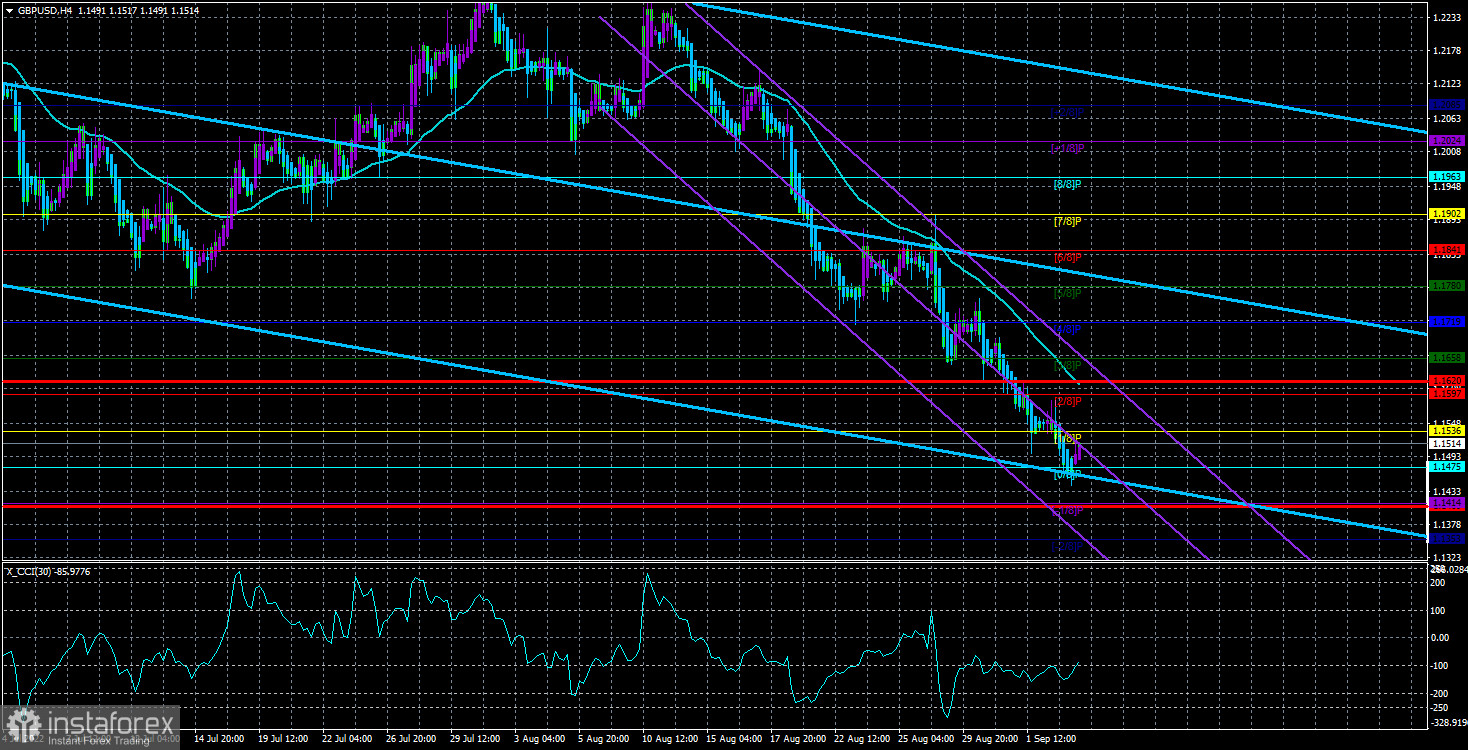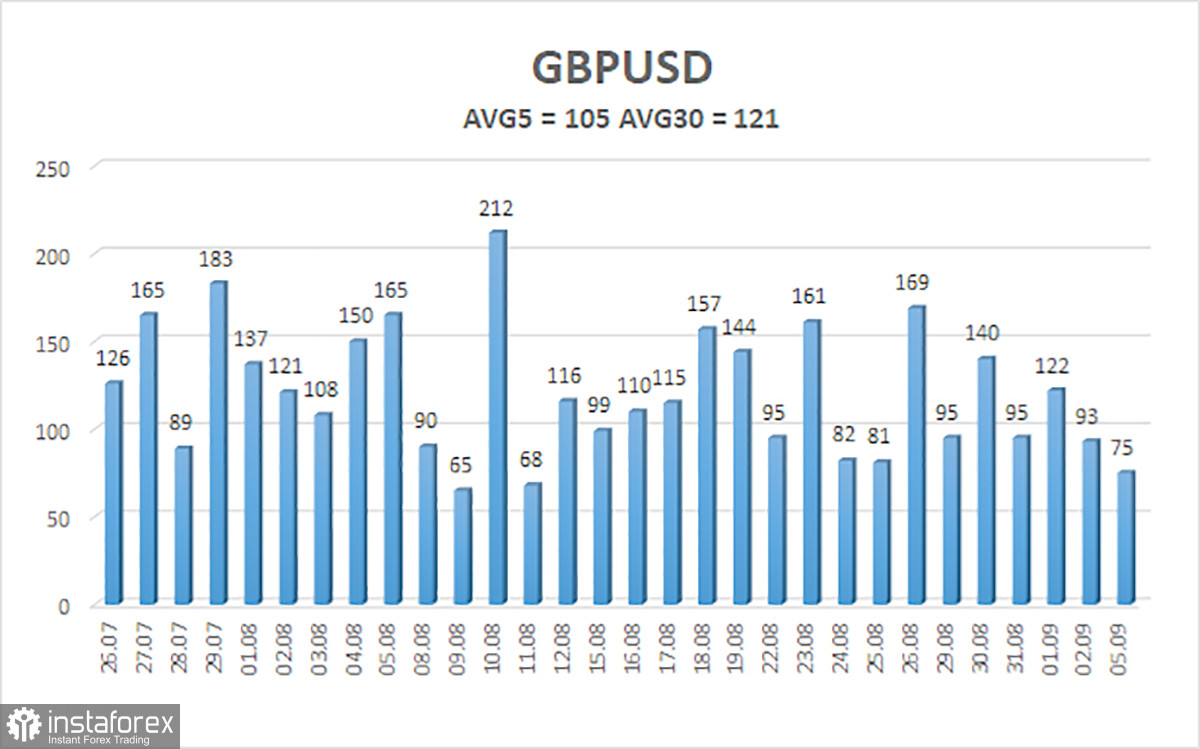
On Friday and Monday, the GBP/USD currency pair kept falling farther and further into the abyss. As we mentioned before, the pound has recently exhibited higher resistance versus the dollar than the euro. It appears that such days are in the past. The pound updates its 2-year lows practically every day and pushes at full speed to its 37-year low if the euro is trapped around the 99th level. Furthermore, suppose the euro currency pays even a little regard to macroeconomics and the foundation and, when they are absent, at least stops its decline. In that case, the pound has decided to emerge as one of the leaders in the decline of the US dollar. The political crisis can be regarded as temporarily over. The identity of the new Prime Minister is already known, Scotland's withdrawal from the United Kingdom has not yet occurred and may not occur, the "Northern Ireland Protocol" does not apply, and the Bank of England is in a hurry for the Fed. It raises the key rate at every meeting, and these things are no longer relevant to traders. It entails a full-scale trade conflict with the EU. The pound/dollar pair's trading behavior is unaffected by all the positive elements or the lack of bad ones in numerous issues. The market seeks to exchange as many pounds for dollars each day.
From our perspective, this is already referred to as an "inertial fall." This means that while there aren't any obvious or compelling reasons for the pound to fall by this much, there is a definite downward trend, and traders can profit from it. Indeed, why purchase a pair if they continue to decline daily? Why try to predict the upward reversal when you can sell daily and make a good profit? Numerous issues plague the British economy and the UK, but conditions in the US are not as favorable as we would want. Only the Fed spokespeople deny that a recession is starting; this is an undeniable fact for everyone else. Unemployment has already begun to climb while inflation is still high.
Nevertheless, the value of the dollar keeps rising. The cost of living will undoubtedly increase dramatically for the British people due to strong and prolonged inflation. Still, we want to remind you that high inflation and high energy prices are not "purely British problems." These are the issues facing many nations worldwide that lack sufficient energy resources and whose central banks have actively invested trillions of dollars in their economies. We do not disagree, however, that the US economy and the US currency currently appear to be the most stable among its rivals. But is it that stable that the pound keeps falling?
The pound won't benefit from macroeconomics this week.
The first report for this week was already made public in the UK on Monday. The business activity index got very close to the key level of 50.0 and ended up being predictably lower than expectations. Business activity indices, however, are no longer particularly important because it is clear to everyone that the British economy will enter a protracted recession. Previously, a reduction in company activity was a sign that the economy was having issues, but now everyone is aware of these issues. No other significant news or events are scheduled for this week in Britain. But why are they required if the market is still actively trading and the trend is unambiguous?
This week, the ISM Services Business Activity Index, which will be released today, is celebrated in the US. The indicator's most recent readings were extremely paradoxical because they showed an increase while the comparable S&P index decreased below the threshold of 50.0. It turns out that two distinct reports for the same sector present wildly disparate values. Maybe today's ISM report will provide a more sensible level. Nothing in America will be fascinating. It turns out that throughout the entire week, we only have two reports, one of which has already been made public. In the past, we might have predicted that the pair would remain flat with little volatility during the week, but not now. Because traders have such a strong urge to trade, movements may continue to be substantial or at least constant.

Over the previous five trading days, the GBP/USD pair has experienced average volatility of 105 points. This is the "average" rate for the dollar/pound exchange rate. Thus, on Tuesday, September 6, we anticipate movement that is contained inside the channel and is constrained by the levels of 1.1409 and 1.1620. A wave of upward correction will begin if the Heiken Ashi indicator reverses direction upward.
Nearest support levels:
S1 - 1.1475
S2 - 1.1414
S3 - 1.1353
Nearest resistance levels:
R1 - 1.1536
R2 - 1.1597
R3 - 1.1658
Trading Suggestions:
On the 4-hour timeframe, the GBP/USD pair is still trending downward. Therefore, until the Heiken Ashi indication appears, you should maintain sell orders with goals of 1.1414 and 1.1353. With goals of 1.1719 and 1.1780, buy orders should be placed when the moving average line is fixed above it.
Explanations for the examples:
Determine the present trend with the use of linear regression channels. The trend is now strong if they both move in the same direction.
The moving average line determines the short-term trend and the direction you should trade at this time (settings 20.0, smoothed).
Murray levels serve as the starting point for adjustments and movements.
Based on current volatility indicators, volatility levels (red lines) represent the expected price channel in which the pair will trade the following day.
A trend reversal in the opposite direction is imminent when the CCI indicator crosses into the overbought (above +250) or oversold (below -250) zones.
 English
English 
 Русский
Русский Bahasa Indonesia
Bahasa Indonesia Bahasa Malay
Bahasa Malay ไทย
ไทย Español
Español Deutsch
Deutsch Български
Български Français
Français Tiếng Việt
Tiếng Việt 中文
中文 বাংলা
বাংলা हिन्दी
हिन्दी Čeština
Čeština Українська
Українська Română
Română

